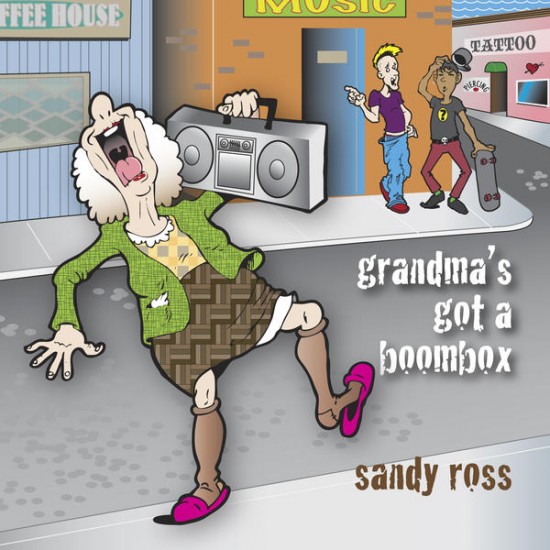
Sandy Ross
Grandma’s Got A Boombox
“I still believe in love,” she sings in “Child of the Sixties,” and that awareness is at the heart of this beautiful new collection of songs by Sandy Ross. She flowered in an idealistic age, a time when proclaiming devotion to love and peace was celebrated, and not dismissed. A time when songs were about a purity of heart, unapologetic about poetics and abstractions. A time when an understanding of a transcendent reality empowered our minds to embrace hope, and our spirits to work for change. A time when gentle songs sung with acoustic guitars were as prevalent as cell-phones are in these modern times.
Videos by American Songwriter
It’s a spirit which is woven through all these songs, through compassion for the earth and its creatures, as well as for the humans who populate it. A beautiful journey in song, it cycles back to what matters most in our hearts and our minds, linked forever to that era of enlightenment and possibility, to that fabled Age of Aquarius.
The 60s was also the time when countless modern standards emerged, songs of great melodicism. Back before the impact of hip-hop, rap, heavy metal – even before reggae came to America – it was all about melody. And from that melodic foundation, Sandy emerged as a songwriter – becoming a staff songwriter back when she started, writing tuneful songs for Anne Murray and others. That embrace of tunefulness permeates this album with a sweetness, which is conveyed warmly in her soulful, unaffected singing. Long past the time when people started declaring the “death of melody,” Sandy Ross is writing beautiful tunes. And tunes that speak to our heart, with words go to the head; it’s at that juncture where this album lives.
It also lives in beautifully rich instrumentation, especially the sparkling guitar of Sandy’s longtime collaborator, songwriter-guitarist Jeff Gold, and the great acoustic bass of Tim Emmons.
The 60s was also a time when drug experiments spiraled towards drug addiction, and that human failing echoes throughout “Alice,” which is connected to the Jefferson Airplane song of the same name, also about a person trapped by addiction. “How high is too high and how low is too low?” she sings of this equation which always adds up to sorrow and failure, leading to a lost soul: “She’s only the shadow of what she had been.”
“Giddyup Joker,” sparked by one of the sweetest melodies of all, is about a beloved horse, but also about that part of us that lived in the distant past when life was simpler, and often sweeter.
The title song, Grandma’s Got A Boombox, is about the joy of music, and how it keeps us forever young. A happy honky-tonk sculpted with great piano by Paul Asaro, it’s also about the juncture of the ages – this grandma’s got a Boombox – but her heart is still with Sinatra. It speaks to the way music – and singers and songs – impact us forever, and we carry them through our lives, like loved ones.
One of the most poignant moments of the albums is when she sings the famous Hebrew song “Erev Shel Shoshanim,” written in 1957 by Yosef Hadar and Moshe Dor, a song often used in weddings. She sings it like she has been singing it her whole life, with purity, and maybe she has. It’s about the garden of lilies, a place of peace and beauty, also connected to the 60s vision of a world beyond chaos and war.
And both “Distant Campfire” and “Honey How Did I Get Here?” point to her devotion for the love of her life, and the light of love itself. As in “Child of the Sixties” with its pedal tone reminder of “love, love, Love,” she reminds us that it’s all about love, even now in these modern times, her campfire in the distance is the symbolic beacon towards which we always set our compasses, so as to navigate these human lives. It’s a lovely and powerful physical symbol, organic and real.
In “Honey” she finds herself far-flung, out on the road, her only map being that which leads her back home, back to her Honey, back to the one to whom she asks existential questions while barreling through America. It echoes David Byrne in Talking Heads when he finds himself in the midst of his life and wonders what led him to that place. Again it’s about the compass – when we are lost, it’s love that helps us get found, and it’s to her love the song is sung.
The epic “Lobo Rey de la Currumpaw” is based on a Thomas Seton story about the last gray wolf; the song’s a great subterranean fable which unfolds over many verses, and reflects the evolution of our own country, as the buffalo and other wildlife were slaughtered. It leads up to the unlikely death of Lobo and of our connection with nature, another message of compassion reflecting the spirit of the 60s.
It all comes back to love – a genuine love for songwriting, a passion for expression, and an endearing spirit of acceptance of life as it has to be lived. I’ve been a fan of all her albums through the years, but this is the best one yet. Some songwriters have never let go of the reason we all started writing songs in the first place – it’s about expression, and about the spirit of hope, change and compassion – all of which ring like a bell through these songs.

One Comment
Leave a Reply